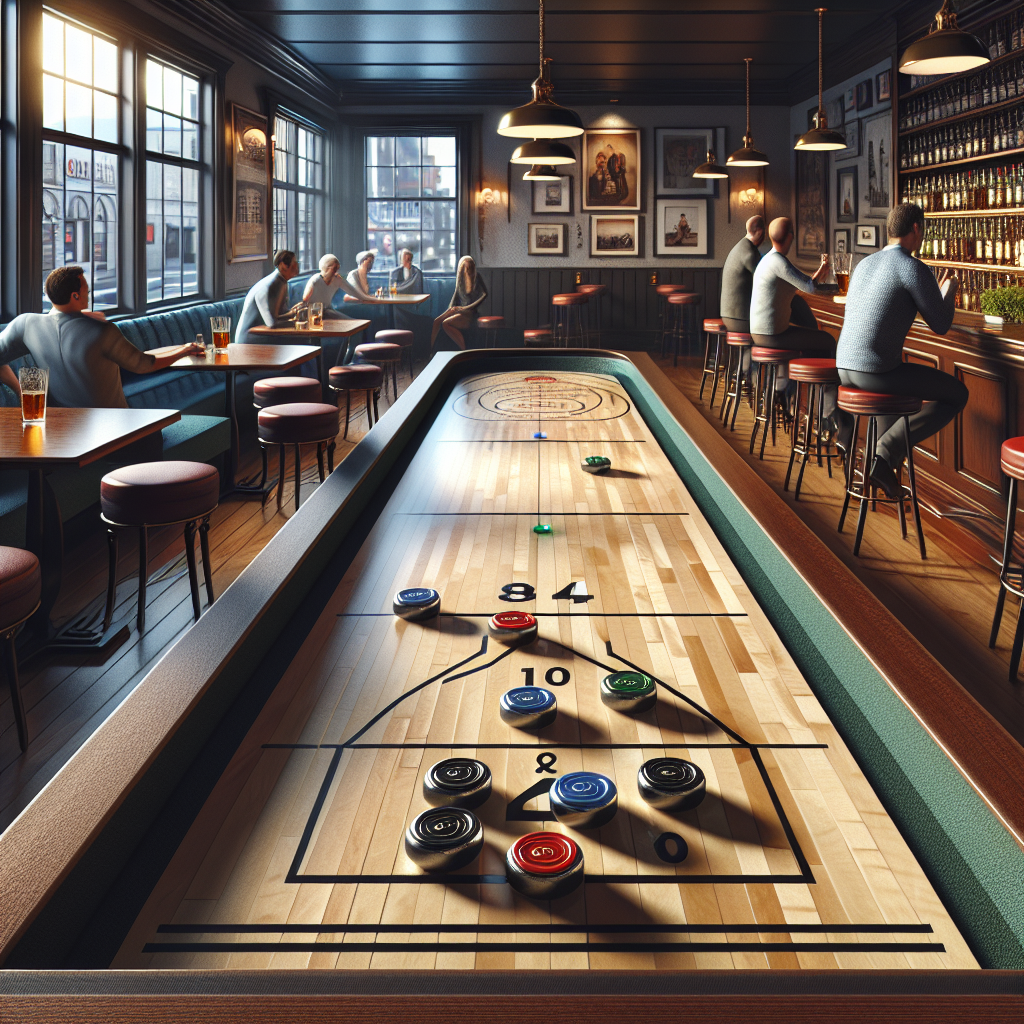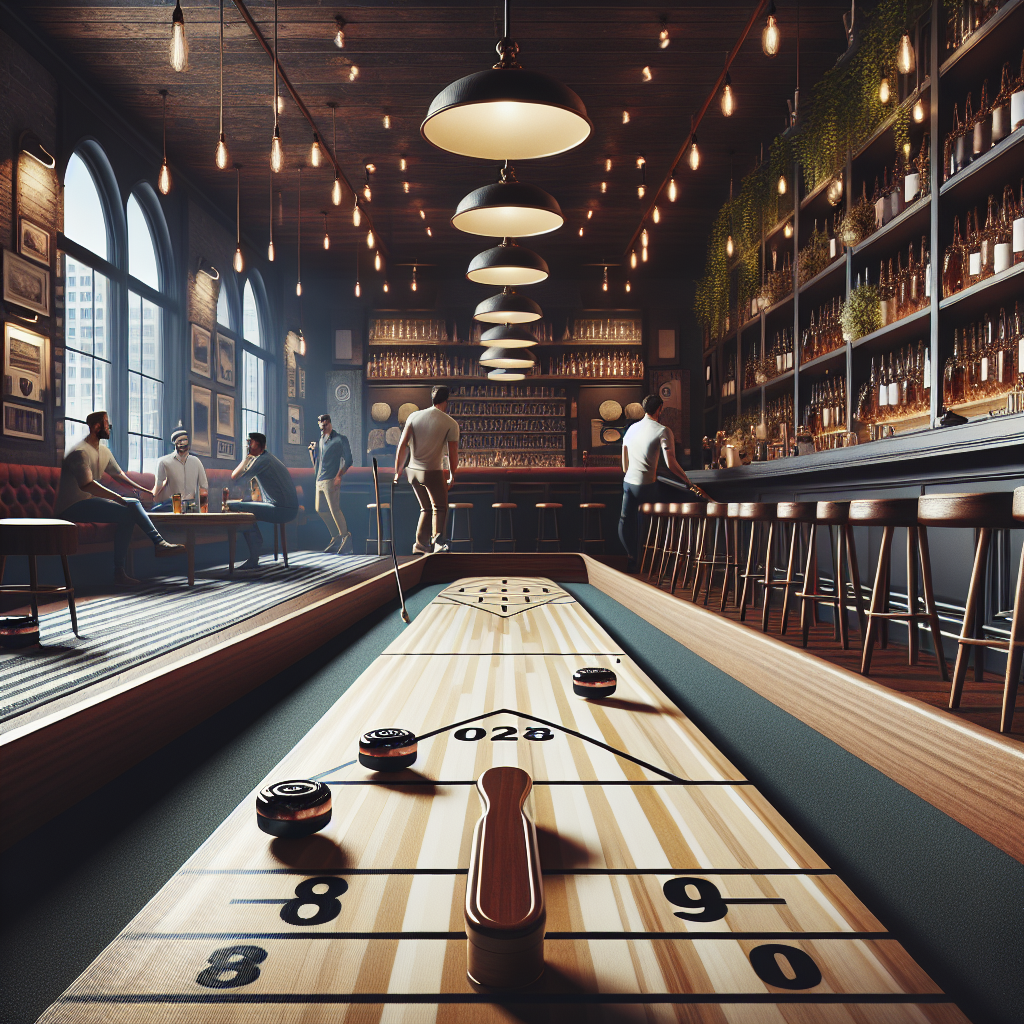Understanding Shuffleboard Scoring
To fully grasp the game of shuffleboard, it’s essential to have a solid understanding of the scoring system. In this section, we will delve into the basics of shuffleboard scoring and explore the different gameplay and scoring zones.
Basics of Shuffleboard Scoring
Shuffleboard games are commonly played to either 15 or 21 points. The objective is for players to alternately slide all four of their weights against their opponent’s weights, aiming to earn points by reaching the highest scoring area on the shuffleboard without falling off the end of the board (McClure Tables).
Gameplay and Scoring Zones
The scoring area in shuffleboard is located at each end of the playing surface. It is divided into three zones: the closest zone, the middle zone, and the furthest zone. Each zone has a specific point value associated with it. The scoring zones may vary slightly depending on the shuffleboard table dimensions, but the general concept remains the same.
Let’s take a closer look at the point values assigned to each zone:
| Zone | Point Value |
|---|---|
| Closest Zone | 1 |
| Middle Zone | 2 |
| Furthest Zone | 3 |
In addition to these three zones, there is an extra scoring opportunity if a puck hangs over the edge of the shuffleboard. When a puck hangs over the edge, it is considered “off the end” and is worth four points (McClure Tables).
It’s important to note that points are only counted if the puck is not touching the line between zones. For example, if a puck lands halfway between zones 2 and 3, the points scored would be 2 (McClure Tables).
Understanding the gameplay and scoring zones is crucial for strategic decision-making during a shuffleboard game. By aiming for specific zones, players can accumulate points and work towards achieving victory. To enhance your shuffleboard skills, be sure to explore advanced scoring tactics and strategies in the subsequent sections of this guide.
With a solid understanding of the basics of shuffleboard scoring and the different gameplay and scoring zones, you are now equipped to dive deeper into the intricacies of scoring techniques and strategies. Remember to refer to the bar shuffleboard rules and familiarize yourself with the dimensions and setup of the shuffleboard table to fully enjoy the game.
Scoring Techniques in Shuffleboard
To master the game of shuffleboard and maximize your scores, it’s important to understand the point system and employ advanced scoring tactics.
Point System Explanation
In shuffleboard, the scoring area on the table is divided into different sections, each worth a specific number of points. The exact scoring system may vary depending on the type of shuffleboard game being played, such as tabletop shuffleboard or indoor shuffleboard.
For example, in tabletop shuffleboard, the scoring area is divided into three sections: the closest section to the edge is worth 3 points, the short middle section is worth 2 points, and the long middle section is worth 1 point. Additionally, a puck hanging over the edge of the table is worth 4 points (Legacy Billiards).
On the other hand, indoor shuffleboard tables may have different scoring zones and points. It’s important to familiarize yourself with the specific scoring system of the shuffleboard table you’re playing on. For a comprehensive understanding of scoring in indoor shuffleboard, refer to our article on bar shuffleboard rules.
Advanced Scoring Tactics
To further enhance your shuffleboard scoring, consider employing advanced scoring tactics. These tactics involve strategic placement of your pucks to maximize points and create challenging situations for your opponents.
One common tactic is to aim for the highest-scoring areas on the shuffleboard table. These areas are typically located closer to the end of the table and offer greater point potential. By consistently targeting these high-scoring areas, you can accumulate points more quickly and gain an advantage over your opponents. For more strategies on excelling in shuffleboard, refer to our article on bar shuffleboard strategy.
Another tactic is to play defensively and offensively. This involves strategically blocking your opponent’s pucks from reaching high-scoring areas while simultaneously positioning your own pucks for maximum point potential. By mastering defensive and offensive plays, you can control the flow of the game and increase your chances of scoring more points.
Remember, shuffleboard is a game of precision and strategy. Practice different techniques, experiment with angles and speeds, and continuously refine your skills to become a scoring master. For more tips and techniques on improving your shuffleboard game, check out our article on bar shuffleboard techniques.
By understanding the point system and implementing advanced scoring tactics, you can elevate your shuffleboard skills and achieve impressive scores. Whether you’re playing tabletop shuffleboard or indoor shuffleboard, mastering these scoring techniques will undoubtedly enhance your enjoyment of the game.
Strategies for Maximizing Scores
To excel at bar shuffleboard and maximize your scores, it’s essential to employ effective strategies. By focusing on high-scoring areas and utilizing defensive and offensive plays, you can increase your chances of success.
High-Scoring Areas Focus
One strategy for maximizing scores in bar shuffleboard is to concentrate on the high-scoring areas of the shuffleboard table. The scoring area is divided into different zones, each worth varying points. Typically, the scoring area consists of three zones: the closest zone, the middle zone, and the furthest zone. The scoring points for these zones can vary depending on the specific shuffleboard table, but a common scoring system is 1-2-3 points respectively.
By aiming for the higher-scoring areas, such as the middle and furthest zones, you have the potential to accumulate more points with each shot. However, it’s important to note that points are only counted if the puck is not touching the line between zones. For example, if a puck lands halfway between zones 2 and 3, it would be scored as 2 points (McClure Tables). Understanding the scoring zones and focusing on the high-scoring areas can significantly impact your overall score.
Defensive and Offensive Plays
In addition to targeting high-scoring areas, utilizing defensive and offensive plays can give you an advantage in bar shuffleboard. Defensive plays involve strategically placing your pucks in positions that block your opponent’s pucks from entering high-scoring zones. By creating barriers or placing pucks strategically along the shuffleboard table, you can make it more challenging for your opponent to score points.
On the other hand, offensive plays aim to increase your own score while simultaneously hindering your opponent’s scoring opportunities. Offensive plays can involve knocking your opponent’s pucks out of high-scoring zones or using the walls of the shuffleboard table to your advantage. By using the walls, you can redirect the trajectory of your pucks, allowing them to land in favorable scoring positions.
To execute defensive and offensive plays effectively, it’s crucial to develop and refine your shuffleboard techniques. Consider mastering techniques such as the Hammer Shot, which involves knocking opponent’s discs out, the Bumper Shot, which uses the walls for strategic positioning, and the Precision Shot, which requires careful aiming for high-scoring areas (Gaming Blaze). These techniques, combined with a strategic mindset, will enhance your ability to maximize your scores and outplay your opponents.
By focusing on high-scoring areas and incorporating defensive and offensive plays into your strategy, you can elevate your performance in bar shuffleboard. Remember to practice your techniques, adapt to different shuffleboard tables, and continually refine your skills. With dedication and strategic thinking, you’ll be on your way to mastering the game and achieving impressive scores.
Abacus Scoring System
In the game of bar shuffleboard, the Abacus Scoring system provides a simple and efficient method for keeping track of points. Using an abacus with beads, players can easily tally scores, making it convenient to monitor points during gameplay (Presidential Billiards).
Abacus Setup and Usage
To utilize the Abacus Scoring system in shuffleboard, players need an abacus with 11 beads. Typically, nine of these beads are black or chrome, representing the points earned by each team. The remaining two beads are of a different color, often red or blue, to differentiate the teams.
The scoring process is straightforward. As points are earned, players slide one black or chrome bead for each point scored. Once a team reaches 10 points, they slide over one of the contrasting color beads, signifying a multiple of ten. This makes it easy to keep track of the score and identify when a team has reached a score of 10, 20, or beyond.
For a visual representation of the abacus scoring system, refer to the following table:
| Abacus Beads | Points |
|---|---|
| Black/Chrome Beads | 1 each |
| Contrasting Color Beads | 10 points each |
Winning with Abacus Scoring
In bar shuffleboard using the Abacus Scoring system, the first team to reach 21 points and have a lead of two or more points wins the game (Presidential Billiards). This ensures that the winning team secures a clear victory over their opponent.
By employing the Abacus Scoring system, players can focus on the game itself rather than keeping track of the score mentally. The abacus provides an efficient and reliable way to monitor points, allowing players to fully immerse themselves in the strategy and enjoyment of bar shuffleboard.
Remember, mastering the abacus scoring system is just one aspect of becoming proficient in bar shuffleboard. To learn more about the game, including bar shuffleboard rules, how to play bar shuffleboard, bar shuffleboard strategy, and more, make sure to explore our comprehensive guide to bar shuffleboard scoring.
Common Mistakes to Avoid
When playing bar shuffleboard, it’s important to be aware of common mistakes that can impact your scores and overall performance. By avoiding these errors and implementing effective strategies, you can enhance your gameplay and increase your chances of success.
Errors Impacting Scores
-
Overwhelming Force: Applying excessive force when releasing the puck can lead to it overshooting the desired target. This can result in losing control and missing out on scoring opportunities. It’s important to find the right balance of strength and finesse in your shots.
-
Neglecting Strategy: Failing to develop a sound strategy can hinder your success in shuffleboard. Without a plan, you may make hasty decisions that don’t maximize your scoring potential. Take the time to analyze the board, consider different shot options, and strategically place your pucks.
-
Ignoring Defensive Play: While focusing on scoring points is important, neglecting defensive play can leave your opponent with advantageous positions. By strategically placing pucks to block your opponent’s scoring opportunities, you can prevent them from gaining an advantage.
-
Lack of Patience: Rushing shots without considering the optimal angle, speed, and placement can result in subpar scores. Taking your time and carefully planning each shot can significantly improve your scoring potential.
-
Poor Positioning: Incorrect positioning on the shuffleboard table can negatively impact your shots. It’s crucial to maintain a stable and balanced stance, ensuring that you have a solid foundation for accurate and controlled shots.
-
Neglecting Table Maintenance: A well-maintained shuffleboard table is essential for optimal gameplay. Neglecting regular cleaning and waxing can lead to inconsistent puck movement and unpredictable scoring outcomes. Keep the playing surface clean and properly waxed to ensure smooth and consistent shots.
-
Losing Focus: Distractions and loss of focus can result in missed shots and poor decision-making. Stay focused on the game, minimize distractions, and maintain a calm and composed mindset to perform at your best.
Enhancing Performance Strategies
-
Practice Regularly: Like any skill, mastering shuffleboard requires practice. Regularly playing and honing your skills will improve your technique, accuracy, and overall gameplay.
-
Analyze the Board: Take the time to study the shuffleboard table and assess the scoring zones. Identify high-scoring areas and strategize your shots accordingly.
-
Observe Opponents: Pay attention to your opponents’ strategies and shot choices. Learning from their techniques can provide insights into effective gameplay.
-
Develop Shot Variety: Having a repertoire of different shot techniques can give you an advantage. Experiment with different angles, speeds, and spins to adapt to various scenarios on the shuffleboard table.
-
Maintain a Positive Attitude: Shuffleboard is a game of skill and strategy. Maintaining a positive attitude, even in challenging situations, can help you stay focused and make better decisions.
By avoiding common mistakes and implementing effective strategies, you can enhance your performance in bar shuffleboard. Remember to stay focused, analyze the board, and practice regularly to improve your skills and increase your chances of success. For more tips and techniques, check out our article on bar shuffleboard tips.
Doubles Match Scoring Rules
In a game of bar shuffleboard, doubles matches bring an added level of excitement and collaboration. Understanding the scoring rules specific to doubles matches is essential for a fair and enjoyable game. In this section, we will explore the collaborative scoring approach used in doubles matches and the penalties for rule violations.
Collaborative Scoring Approach
In doubles matches, teammates stand on opposite ends of the shuffleboard table and take turns playing. Each player shoots from alternating ends of the table, and teammates work together to strategize and score points. It is important to note that players are not allowed to go to the other end of the board to see the position of the pucks and must rely on their partner’s information.
The objective of the game remains the same as in singles matches: to score points by getting pucks as close to the far end of the table as possible without going beyond the scoring area. Once all the pucks have been played, points are tabulated based on which team’s pucks are closest to the far end. Only one team can score points on any given round, regardless of the number of pucks each team has in the scoring area (McClure Tables).
The first team to reach the predetermined point threshold wins the doubles match. In a two-player game, the threshold is typically fifteen points, while in a four-player game, the threshold is often twenty-one points (Legacy Billiards). It’s important to establish the point threshold prior to the start of the game.
Rule Violations and Penalties
To ensure fair play and maintain the integrity of the game, shuffleboard imposes penalties for rule violations. In doubles matches, rule violations can result in a one-point penalty. Here are some common rule violations that may incur penalties:
-
Rubbing hands over the playing surface: Players should avoid touching the playing surface with their hands during the game. Rubbing hands over the playing surface can cause disruptions and affect the movement of the pucks.
-
Extending the lower half of the body past the end of the board: Players must refrain from extending any part of their lower body past the end of the shuffleboard table. This rule ensures that players maintain a fair playing position and do not gain an unfair advantage.
-
Holding a playing puck while the opponent is shooting: Players should not hold a playing puck while the opponent is shooting. This rule prevents interference and ensures a fair game.
-
Causing table vibrations: Players should avoid actions that cause excessive table vibrations during the opponent’s turn. Vibrations can affect the trajectory and accuracy of the opponent’s shot.
By adhering to these rules and penalties, doubles matches can proceed smoothly, allowing for a competitive and enjoyable experience for all participants. Remember to familiarize yourself with the specific rules of the shuffleboard establishment you are playing at, as rules may vary slightly from place to place.
Now that you understand the doubles match scoring rules, you can confidently engage in collaborative play and strive for victory alongside your teammate. So gather your partner, step up to the shuffleboard table, and enjoy the thrill of doubles competition.








